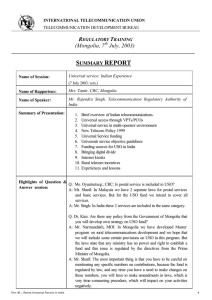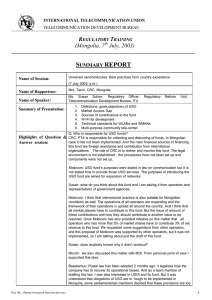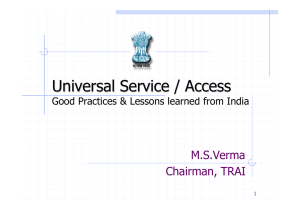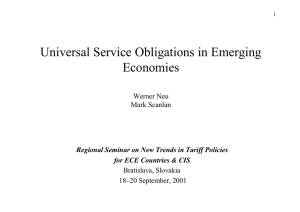MANAGING TRANSITION IN THE UNIVERSAL SERVICE REGIME IN VIEW OF
advertisement
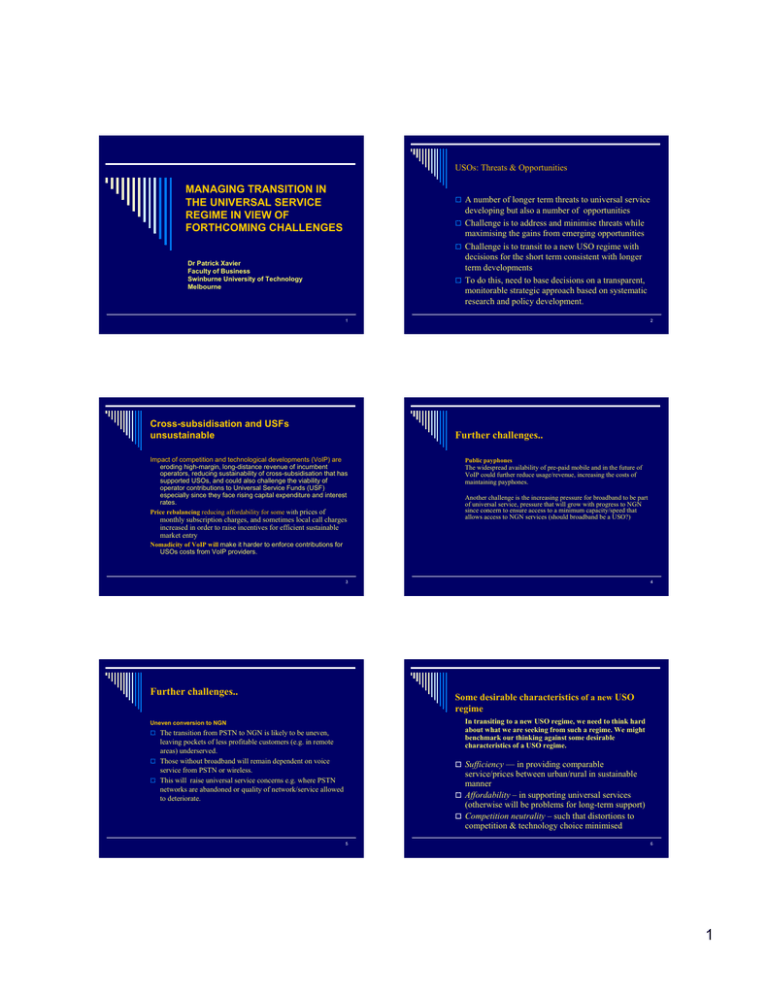
USOs: Threats & Opportunities MANAGING TRANSITION IN THE UNIVERSAL SERVICE REGIME IN VIEW OF FORTHCOMING CHALLENGES A number of longer term threats to universal service developing but also a number of opportunities Challenge is to address and minimise threats while maximising the gains from emerging opportunities Challenge is to transit to a new USO regime with decisions for the short term consistent with longer term developments To do this, need to base decisions on a transparent, monitorable strategic approach based on systematic research and policy development. Dr Patrick Xavier Faculty of Business Swinburne University of Technology Melbourne 1 Cross-subsidisation and USFs unsustainable 2 Further challenges.. Impact of competition and technological developments (VoIP) are eroding high-margin, long-distance revenue of incumbent operators, reducing sustainability of cross-subsidisation that has supported USOs, and could also challenge the viability of operator contributions to Universal Service Funds (USF) especially since they face rising capital expenditure and interest rates. Price rebalancing reducing affordability for some with prices of monthly subscription charges, and sometimes local call charges increased in order to raise incentives for efficient sustainable market entry Public payphones The widespread availability of pre-paid mobile and in the future of VoIP could further reduce usage/revenue, increasing the costs of maintaining payphones. Another challenge is the increasing pressure for broadband to be part of universal service, pressure that will grow with progress to NGN since concern to ensure access to a minimum capacity/speed that allows access to NGN services (should broadband be a USO?) Nomadicity of VoIP will make it harder to enforce contributions for USOs costs from VoIP providers. 3 Further challenges.. 4 Some desirable characteristics of a new USO regime In transiting to a new USO regime, we need to think hard about what we are seeking from such a regime. We might benchmark our thinking against some desirable characteristics of a USO regime. Uneven conversion to NGN The transition from PSTN to NGN is likely to be uneven, leaving pockets of less profitable customers (e.g. in remote areas) underserved. Those without broadband will remain dependent on voice service from PSTN or wireless. This will raise universal service concerns e.g. where PSTN networks are abandoned or quality of network/service allowed to deteriorate. Sufficiency — in providing comparable service/prices between urban/rural in sustainable manner Affordability – in supporting universal services (otherwise will be problems for long-term support) Competition neutrality – such that distortions to competition & technology choice minimised 5 6 1 Managing transition to new USO regime through systematic USO strategy New USO regime – some desirable characteristics Flexibility – in adapting to new technology and USO re-definition of USO coverage Protection and advancement of network and quality of service – through sustained incentives to upgrade service Portability – so as to provide all eligible operators with support so that “contestability” for the USO market is maintained. Predictability – e.g., in enabling operators to determine in advance the amount of support, thus helping long-term planning Practicality – in that programmes are economically & administratively viable Transparency – in being open to monitoring & performance review Cost-effectiveness – such that aims are achieved at least cost (e.g. use of competitive tendering) and the use of the USO regime to leverage sustainable investment in rural/remote areas. Lessons of international experience counsel the need to develop USO strategy in systematic & transparent manner. This involves: specifying explicit objectives/measurable targets including quality of service targets and time frame for achieving these targets facilitating market provision addressing barriers to market provision And for areas the market is less able to serve, identifying competitively & technology neutral USO delivery mechanisms 7 8 In defining scope of USOs, need to be constrained by the recognition of inefficiencies that can be caused by USOs Managing Transition to new USO regime through systematic USO strategy USOs can generate substantial inefficiencies: subsidization programs can restrict or distort competition and availability/choice of technology in rural/remote areas can discourage potential market entrants facing prospect of competition against a subsidized provider (offering services at prices below costs); can suppress market signals and accordingly Costing and cost-effective financing of USOs monitoring & assessing success/failure of USO programmes with a view to remedial action. In some countries such as Australia, Hungary, UK, India, the strategy development process has commenced with a public consultation document seeking views of stakeholders. Such an approach is consistent with the transparency required by the WTO Reference Paper on telecommunications. market development in service provision because they are not means-tested, USOs operate in some cases to advantage those who do not need subsidies; moreover a USO ‘one size fits all’ approach is wasteful, because people have differing preferences; USOs raise costs for other customers, thus arguments on behalf of uneconomic subscribers should be constrained by concerns not to impose unreasonable cost burdens on other (economic) subscribers. 9 10 Market liberalisation, technological innovation & USO Facilitate market provision Emphasis on market provision does not argue that the market will resolve all problems. It does argue, however, that the market must not be impeded from doing so. This is because: Greater is market supply, the fewer areas/people needing subsidy assistance, and therefore the greater is capacity to assist them Effective way to achieve universal service objectives in a sustainable way is through market-based, commercially viable business Market liberalisation will facilitate the introduction of costeffective technology available now and in future. 11 This is critically important with technological change on the horizon, including: Wireless technology (which, indeed, has already dramatically increased access), and promises more through the potential of Wi-Fi, Wi-Max, IP Wireless, CDMA 450, etc Satellites, including VSATs Powerline, and most recently the promise of… “Stratellite” technology. For instance, it is claimed that a single “Stratellite” airship could cover 800,000 sq km, i.e. providing service to entire cities not just Wi-Fi “hotspots” or Wi-Max’s 50 km coverage. 12 2 Market liberalisation, technological innovation & USO Another challenge is to increase investment incentives e.g., by limiting price regulation Point being made is that the market must be kept open to allow introduction of cost-effective technologies including the prospect of New and creative enterprises that can make rural and low-income markets profitable, affordable, and sustainable. Another important point is that like telephony, broadband no longer requires wires – and this will help to increase access in rural areas. To facilitate innovative entry, spectrum allocation & management should be reformed, with liberalised “spectrum trading” and leasing permitted and special allocations for service to rural/remote areas. Spectrum trading can enhance the prospect of greater wireless deployment in underserved areas e.g., rural areas. For example, this could make it possible for a carrier with a regional or nationwide license to lease or sell spectrum to a rural carrier to build networks in rural areas. Regulators could also: allow price movement to boost investment incentives, but maintain vigilance to anticompetitive conduct (predatory pricing, price squeeze, etc). Abandon direct government price controls in favour of “price cap” regulation, including specific ‘price caps’ on monthly line rentals (eg. CPI +2%). But such regulation should be limited and abandoned as soon as possible, in order to increase investment incentives. Affordability may be affected and here a particular problem is service to disabled, low income, disadvantaged, consumers in both urban as well as rural areas. In such cases, mechanisms directed at consumers (rather than service providers) can be more effective in achieving affordable service, flexible tariff packages, control of expenditure and payment of bills. 13 Key issue: financing universal service 14 Some funding from taxation revenue? Universal Service Funds can receive finance from Operator contributions % of revenue contributed by operators, which has ranged from 1% (Argentina, Brazil), to 5% (India) and 6% (Malaysia) But, as viability of USF being challenged by developments in VoIP, etc. need to consider other financing of USOs as well. Government revenue There could be greater contribution from: spectrum auctions (3G), spectrum pricing proceeds of privatization of a telecom operator (Australia) government taxation revenue (e.g. Chile) local government and other government departments USOs rationale based largely on social /equity grounds. This raises the question as to whether the cost of pursuing such social/political objectives be more significantly funded from general revenue? It is arguable that funding from taxation revenue accords more closely with efficiency and equity criteria (upon which taxes are based) Many, including regulators, acknowledge that government funding is the most suitable source but then quickly move on saying “not feasible”. However, recently even some governments (e.g., Australia) have begun to acknowledge that ‘in principle’ government funding may be appropriate. 15 16 Conclusion Conclusion Presentation has taken a longer term view of threats and So managing the transition to a new USO regime and the aim of universal access programs is not just how to collect and spend money through a universal service fund, but to foster investment in infrastructure and service development through a strategic approach. Thus, a clear guiding principle should be that the universal service fund not be used as a substitute for private market incentives and investments. It should be non-discriminatory and not interfere with competitive market forces. Finally, systematic monitoring and evaluation based on good up-todate ‘supply-side’ and ‘demand-side’ information is critically important to ensure that USO targets are being achieved according to schedule. Also important are regular “audits” of the economy, efficiency, and effectiveness of the administration of universal service programmes (in order that confidence in, and support for, the new USO regime is maintained). THANK YOU opportunities concerning universal service because even pressing short term decisions should keep these longer term developments in mind. For instance, in deciding how much of the burden of universal service operators should bear, the developing financial stress on them should be recognised. The longer term technological developments on the horizon pose shorter term questions such as should a country wait for WiMax? 17 18 3

